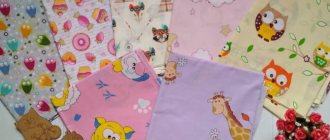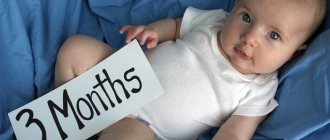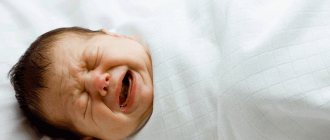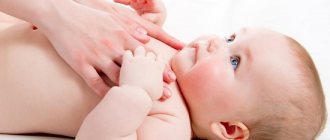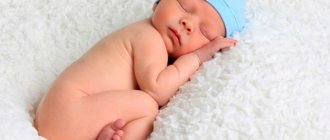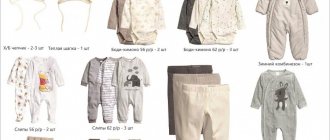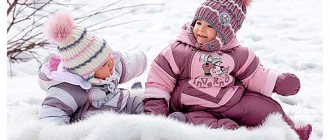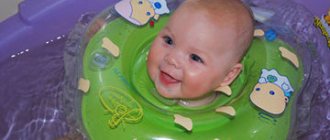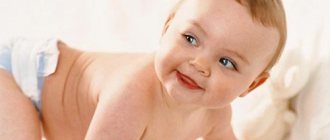After birth, the baby’s environment changes dramatically, so the newborn’s body experiences some stress. At first, it is very important to observe the thermal regime of the room where the baby is located in order to help him quickly adapt to the external environment. Before dressing your newborn at home, it is worth considering that the baby’s thermoregulation system is not yet perfect: the sweat glands are not sufficiently developed and are not yet functioning. Therefore, in case of overheating, the body will not be able to remove excess temperature through sweat, as happens in an adult. At the same time, the fat layer, which protects the body from hypothermia, is also not large in an infant, and will not be able to protect the child from the cold.
Optimal home temperature for a baby
Some believe: the higher the temperature in the room, the warmer the child will be. This is not entirely true. It is much more comfortable for a baby to stay in a cool room. If the temperature is inappropriate, the newborn's sleep will be restless. As a result, he will begin to have difficulty falling asleep, will constantly wake up and be capricious. Therefore, it is important to maintain the optimal temperature in the room for the baby.
Important! A suitable temperature for a baby is from 20 to 24 degrees. Then the baby will feel comfortable.
It is worth organizing free air circulation. To do this, get rid of the canopy on the crib. The now fashionable sides are also not needed!
Walk in the summer
It is easiest to dress a baby in the warm season. During this period, the main task of parents is to avoid overheating. Here are the main nuances:
- Things should be made from natural fabrics: cotton, chintz, light knitwear.
- The baby should be dressed as lightly as possible, but the skin should not be exposed. After all, it can easily burn under direct sunlight.
- What to dress a newborn in summer? You can choose a T-shirt and shorts for him, and dress up the girl in a dress. The main thing is to cover your head with a Panama hat to protect it from the scorching sun.
Mothers should not walk with the baby from 12 to 16 hours of the day. In summer, it is best to be outside early in the morning and in the evening. It is important for mothers to have two diapers with them (thin and flannel). If a cool breeze blows, you can cover the child with one of them.
How to tell if a newborn is cold or not?
You can assess your child's temperature-related comfort level by touching his back. If the upper part and neck area are cold, it means he is cold. But this is not the only way to understand the situation.
There are several signs by which you can recognize whether a baby is cold. Among them:
1. Feel the folds of your arms and legs. If the skin there is cool, you should dress your baby warmer.
2. If your baby's skin is wet and hot, it means he is hot. It's worth undressing him a little.
These methods will allow you to understand how well the baby is and how he feels.
Important! Be sure to pay attention not only to the thermometer readings, but also to the baby’s condition. If an adult is warm, this does not mean that a newborn is not hot.
Why go for a walk with your child?
All young mothers know that they need to take their babies for walks. Here are the main advantages:
- staying in the fresh air strengthens the child;
- immunity and body resistance increases;
- the development of the baby’s nervous system improves;
- the body is saturated with oxygen;
- metabolic processes are enhanced;
- The skin receives the necessary portion of ultraviolet radiation, under the influence of which vitamin D is produced.
Walking trains a baby's vision, as his gaze often shifts from close to distant objects.
How to dress a newborn outdoors according to the weather? This process has its own characteristics, which will be discussed further.
The baby hiccups - is he cold?
If the room is too cool, the baby's muscles begin to tense and the stomach puts pressure on the diaphragm. As a result, the baby experiences an attack of hiccups. But that doesn't mean he's cold. Therefore, there is no point in wrapping him up warmer. Such a reaction of the body indicates that it can adapt to temperature changes. This is a sign of good baby development.
Hiccups can also occur for other reasons:
- Excessive feeding. If you overfeed a newborn with formula, he may start to hiccup.
- Decreased body temperature.
- Swallowing air.
If a child eats more formula than he should, his stomach begins to quickly stretch and fill. As a result, diaphragm spasms appear, causing hiccups.
When breastfeeding, this situation can be avoided. This is due to the easy absorption of mother's milk. Thanks to this, there is no strong pressure on the stomach, which has not yet fully strengthened.
It is important to strictly adhere to the dosage when feeding with formula. Do not neglect the rules indicated on the jar.
When a mother breastfeeds, the baby may latch on poorly, causing him to swallow air along with the milk, which will lead to hiccups. It is necessary to correct the breast latch and help the child do it correctly. Then he will not hiccup and will gain weight in a timely manner.
Bathing
The baby is bathed every day. If a child is unwell or excessively restless, you must first find the cause of the worry and eliminate it.
If there is an elevated temperature or acute infection, the child should not be bathed. The same applies to the days of preventive vaccinations.
Preparing for a swim
You need to make sure that the room where you are swimming is warm enough, about 30 degrees.
Most often, the child is bathed in the kitchen or bathroom. First, things are prepared: a warm diaper is placed on the surface, then a thin diaper, and a terry bath towel on top. A warm and thin undershirt, a warm and thin hat, a diaper are placed nearby, and a bottle of boiled oil is placed.
Place a special stand with a hammock in the baby bath and fill with warm water (36 - 38 degrees), approximately 1/3 of the height of the bath.
Newborn's first baths
During the first baths, the water is disinfected with a weak solution of potassium permanganate. To do this, add a little pre-prepared solution to a bath of water until the water turns pink. In the future, you can add infusions of herbs (chain, oak bark, chamomile, motherwort) to the water.
Baths with a series will be useful for children with allergies; infusions of oak bark and chamomile will have an anti-inflammatory effect. Children with increased excitability can be given a course of baths with motherwort infusion.
The use of herbs for baths must be agreed with a pediatrician!
Bathing a newborn in a hammock
After preparing the bathing water, take the naked baby in your arms and carefully place him in the hammock. The hammock is very convenient because the child’s head is always above the water level, and there is no need to constantly hold it.
The baby lies in the water, the mother takes water into her palm and carefully strokes the baby’s body. For wiping while bathing, it is very convenient to use a terry mitten - a washcloth.
At first, special bathing products are not used. Daily bathing in water with herbal infusions is usually sufficient. Later, from 5 to 6 months, you can purchase baby shampoo and bubble bath.
Bathing time is not strictly limited, on average from 15 minutes to half an hour. It is important to control the temperature of the water in the bath by adding hot water little by little. It is necessary that the baby is pleased and does not show signs of anxiety.
How to dress a baby at home?
First of all, it is recommended to decide not on the clothes, but on the material from which they are made. Natural fabric, calm colors and soft to the touch are better suited. Choose products with seams facing out. This way nothing will rub the baby’s delicate skin.
Advice! It is better to avoid zippers; fasteners should not cause discomfort to the baby. It is better if they are at shoulder level. It's convenient and safe.
The following clothes are suitable for home:
- Romper and bodysuit.
- Pants with open heels.
- Jumpsuits with sleeves of different lengths. Both short and long ones are suitable.
- Baby vests. Any sleeves, as in the previous version, will do.
- Diapers. Thin or flannel.
During the first month of life, it is recommended to swaddle the baby to facilitate the transition from life inside the mother’s belly to normal conditions.
If the thermometer in the room shows about 23 degrees, it is enough to put on a blouse and wrap the baby in a diaper. His thermoregulation process has not yet been formed. Therefore, when staying far from mom for a long time, it is recommended to supplement the crib with something warm. It is important that the blanket does not cover the baby’s face.
You can refuse the cap, but only if the room is above 18 degrees Celsius. If the room is cool, you should dress your child warmer. A fleece overall will do. In winter, if the house is warm, you should choose a cotton blouse and rompers for your baby.
General tips for choosing clothes for a newborn
- Choose things made from good quality natural fabrics. It is desirable that the clothes that are in direct contact with the baby’s body are soft and pleasant to the touch, because the baby’s skin is very delicate.
- Rhinestones, beads, decorative flowers and bows are taboo for babies. No matter how much you would like to dress your baby in something like this, it is better to save such outfit options for an older child. Any such decorations can injure the baby or simply disturb him. A newborn is unlikely to appreciate beautiful but uncomfortable outfits.
- The seams on clothes should be smooth and soft, especially the internal ones.
- It is better to avoid bright acidic colors, because it is possible that harmful dyes are used in the production of such things, which can cause allergies in the baby.
- It is better to buy clothes for your baby as he grows. To begin with, there will be enough kits that will be useful for the season in which the baby will be born. The rest can be purchased “after the fact,” based on the weather and the child’s weight/height.
Does a baby need a cap and socks at home?
Some even put a cap on their child at home for fear of catching a cold in the head or ears. The chances of such an outcome are minimal, so there is no need to use a cap at home.
Reference! Children are much more difficult to tolerate overheating than cold, so there is no need to choose a hundred clothes.
You can refuse socks if the temperature at home is normal and the baby’s legs are covered, for example, with rompers or overalls.
If the feet are open, you can dress the baby in socks. It is normal for a baby to have slightly cool feet. This is an indicator of normal thermoregulation. Therefore, when feeling a child, you should not be afraid that he is cold.
It is necessary to constantly monitor the condition of the child and his environment. This will keep him healthy and not complicate the situation by overheating due to a large amount of clothing.
What should a guy wear to the club?
Gift from husband: 55,000 dresses
Extract from the maternity hospital: what should you take?
For this event, parents prepare especially carefully - they buy the most beautiful and fashionable vests, a suit, an envelope, a blanket, etc. But you shouldn’t pack too many clothes, because in reality you won’t need that much:
- 1 x thin one-piece jumpsuit
- 1 cap and/or cap (depending on the season and weather)
- 1 suit (depending on the season and weather)
- 1 pair of socks
- 1 warm overall (depending on the season)
- 1 envelope for discharge
- 1 blanket (possibly)

